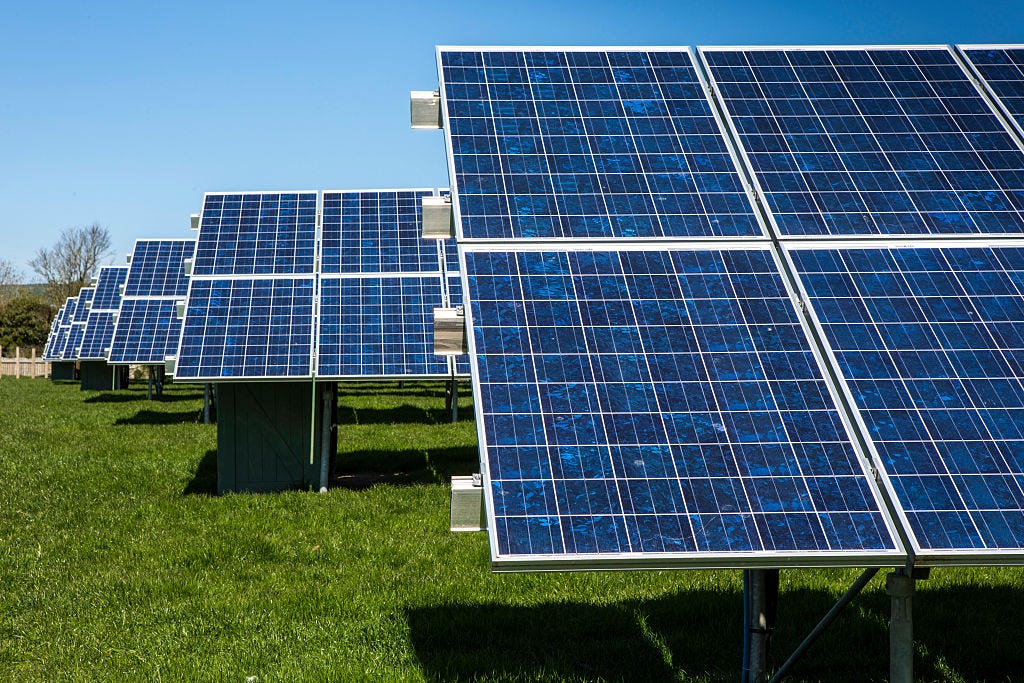A Thing So ‘Shocking and Offensive’ It Literally Can’t Be Permitted
We better come to terms with solar panels soon

Vermont gets a good press, and I’ve generated my share of it—especially after the pandemic years I’m proud of the Green Mountain State. But this is a different kind of story: a story of a state that’s failing to understand we’re actually in a climate emergency, and so continuing with business that looks a lot like usual. I think that that’s typical of too many places—and since science says that business as usual must end right now to deal with our crisis, it seems to me a story worth telling.
It begins with a man named Thomas Hand, who grew up in the Manchester region of the state, along its southwest border not far from Massachusetts. His father and uncle owned the town Chevy dealership; he grew up working on cars, before making it up Route 7 for college at Middlebury, where I met him as a young and idealistic student—among other things, his mechanical abilities helped him pilot a biodiesel schoolbus across the country to promote alternative energy, filtering grease from Chinese restaurants to fill the tank. “Sometimes it makes us hungry driving,” the 21-year-old Hand told reporters. “You can fill up at the same place your car does.”
He took his education and his practical skills and his passion, and in the years since graduation has built a small business constructing solar farms in different parts of the country—precisely the work that physicists tell us is the most important task on earth, since if we can’t cut our fossil fuel emissions in half by 2030 we will have no chance at meeting the climate targets we set in Paris just six years ago. Because he knew the terrain of his boyhood best, many of Hand’s projects have been built there—often out of sight in the abandoned slate quarries that pock the landscape. “But the reality is there are only so many old pits,” he says. “The reality is that you can’t hide all these things. You can hide some of them, but not all.”
And so he took an option on a plot of land on a road near the town of Manchester, and began drawing up plans for a 500 kilowatt solar array on the eight-acre parcel, not far from a group of homes. “We knew folks wouldn’t want to see it, so we offered to screen it from the start,” he said. He spent $20,000 hiring an “aesthetics expert” and coming up with the plan for plantings—three hundred trees and bushes. Those didn’t placate the neighbors, but after six public meetings over the course of a year the town granted it the necessary permits, at which point Hand applied to the state’s Public Utilities Commission for a “certificate of public good.”
And that’s where the process went off the rails.
With the state now in charge, the neighbors issued a reprise of their objections. Their letters are listed in the record: “this is unfair to property owners who will see property devaluation and suffer detraction to their daily life.” “This solar array will detract from their view and their pocketbooks due to the decrease in property value. In turn this will drop prices for property and every homeowner.”“It will change the feel of our neighborhood and it will decrease the value of our property. In my opinion, there is no place for it.”
And fair enough. These are not millionaire second-home owners (of which Manchester has its share); these are just normal people. No one likes change, and solar arrays are not, in and of themselves, beautiful. I have two of them in the backyard—they dominate the view to the north, about twenty feet from the porch. They’re ungainly racks of steel and glass; I’ve left a beachball-sized wasp nest hanging from the bottom of one, both because it means they won’t build in the same spot next year and because it makes it look a bit less sterile.
But as Hand points out, the Manchester land is zoned “mixed use.” Any developer could buildt dozens of condos on the site, or a warehouse, “or a paddle tennis court with 16-foot-high lights.” (There’s a warehouse down the road.) And if those had been proposed, the state’s public utility commission would not have been in a position to do what they did in this case: turn down Hand’s proposal, entirely and explicitly on aesthetic grounds.
Their 54-page ruling goes through a long checklist of damage the proposed array won’t do: it wouldn’t interfere with historical artifacts, it wouldn’t “damage public investment,” it wouldn’t “endanger public health.” Also, it won’t affect the Indiana bat because the only possible roost tree won’t be cut down, it won’t impact the wood turtle (an “S-3 ranked uncommon species”) because the fencing would have holes for “wood turtle entry and exit.” Indeed, the sole and only quibble that the state’s hearing examiner raised concerned the appearance of the arrays. And here he had to overrule not only the aesthetics expert that Hand had hired, but also the aesthetics expert designated by the state’s own Department of Public Service, who had given his official blessing:
“the limited views where the Project will be visible are mitigated by the proposed landscape mitigation plan in conjunction with existing mitigating factors like the relatively short duration of view and highly limited viewshed area. In addition, the Project fits with existing land uses.”
Against all that, the commission and their hearing officer ruled instead that because some of the screening trees would be deciduous, views might not be fully blocked in winter; that (like most spots in the Green Mountain State) there was a mountain—in this case Mt. Equinox—in the '“viewshed;” that the color scheme of solar panels (“dark or galvanized steel in color”) is “out of context with the area;” and that in sum the project would be “offensive or shocking to the average person.” Because the screening trees would take several seasons to fully grow, the commissioners opined, “all residents of the subdivision would see the Project as they enter and exit.”
I’ve tried to talk to some of those involved in the decision—because there’s still weeks to go before appeals run out, I’ve gotten ‘no comments.’ But here’s what I think they might say: Vermont already has clean electricity. Which—thanks to massive purchases from the Hydro Quebec complex in Canada—is true, albeit more fully on paper than in fact. (Also true: you need to ignore the fact that Hydro Quebec reengineered vast swaths of wild land building out their scheme).
But the point is not the present but the future: Vermonters, like Americans eveywhere, run up large carbon totals driving cars and heating their homes with oil and gas; these all need to be converted to electricity this decade to meet the state’s carbon goals. By Hand’s estimate, it’s a thousand gallons of fossil fuel per Vermonter. So we need more electricity—a lot more. Some can come from rooftops, and some can come from gravel pits, and some is going to need to come from where we can see it. In cornfields, say, which cover much of the Champlain Valley north of Manchester. If you think about it, a field of corn is just another form of solar collector, in this case converting sunlight into grain to feed dairy cows, who produce a commodity—milk—that we have in enormous oversupply. (Oh and this kind of solar collector requires that you dump nitrogen on the fields to make it grow, nitrogen then washes into Lake Champlain, turning it green with algae). Electrons, by contrast, are a crop we need more of, and now. Arrays can sit on top of farmland without damaging the underlying soil; indeed Vermont farmers are even learning to grow crops and graze animals in the fields.
So it would be better if our leaders—Public Utility Commissioners, say—sympathetically but truthfully explained to people why we need more solar energy. Perhaps they could point out that we’ve seen more wildfires this year than ever before, that tens of millions of people have already been made refugees by climate change, that the very trees that turn this time of year and make Mt. Equinox so beautiful are at risk because of the rising temperature. If property values are trimmed a little (and property values have soared across Vermont in recent years), that has to be weighed against the people who are literally losing their Pacific island nations, their Asian delta rice farms—all through no fault of their own, since their carbon emissions are rounding errors compared with ours.
None of this is easy: no one, especially politicians, like telling people that we need to change. That’s why it’s been so hard not just to build solar panels and wind turbines (which are effectively blocked in Vermont), but to densify housing in cities across the country, even as everyone acknowledges it would help us cope with impossible housing costs and ruinous commutes. It’s why we have trouble siting everything from homeless shelters to drug treatment centers, even amidst desperate need. I’ve advocated over the years for renewable energy near the places that matter to me, and I’ve lost friends in the process. It’s hard because there’s no one-to-one correspondence between building a solar array in Manchester and saving a Bangladeshi farm from the rising tide. But if we don’t do a lot of the former, than the latter is guaranteed,
The ultimate irony is that the commissioners actually did have to consider climate change in their opinion, ruling tersely that “the project would not result in undue air pollution or greenhouse gas emissions.” They’d checked a legal box, and their finding was true enough, but the real point of course is precisely the opposite: such projects are our only real hope of cutting those emissions while we still have time. It would have been right to at least acknowledge that bedrock truth in passing.
Building clean energy is the project of our era on earth. And at some level it really is an aesthetic issue. When we look at a solar panel or a wind turbine, we need to be able to see—and our leaders need to help us see, because that’s what leadership involves--that there’s something beautiful reflected back out of that silicon: people finally taking responsibility for the impact our lives have on the world and the people around us. We are in an emergency, and an emergency calls for imagination, for literally seeing things in a new way. To hide that truth behind a screen of words is—well, offensive and shocking.
Enter your thoughts here





Frustrating but all-too-real situation. I think a possible solution is ownership models that allow these homeowners to co-own these solar/generation assets. This would mean that when looking out at a solar farm or wind turbine, individuals would see something helping pay off their mortgage or save for retirement, rather than an "eyesore" that is owned by a private entity. The property itself could even be tied to the co-ownership of the system to help address the property value argument.
Bill, so frustrating! We need to promote climate change literacy in our communities and schools so all can get beyond the NIMBY syndrome.